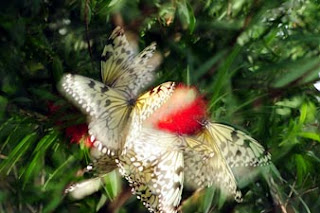I don't live in the rain forest, so my favorite environment to photograph butterflies is at our local Butterfly Pavilion in Westminster, Colorado. They do a great job of replicating the butterflies' natural environment--dress lightly!
There are several concepts/principles to consider. I'd like to share a few with you. First, most, if not all, butterfly pavilions do not allow tripods--that will create some challenges for you! Let's assume, for the sake of these pointers, that you'll be doing your shooting with a hand-held DSLR or film SLR.
1) Shoot at wide apertures-- This will allow you to convert cluttered backgrounds into soothing backdrops. It will also allow you to shoot at higher shutter speeds to keep your images as sharp as possible. Depending on the position of the butterfly, I usually shoot anywhere from f/2.8 to f/8.
2) Use ISO 400-800 if you have to (and if your camera can still give you great images at those sensitivities)-- sometimes I just can't get a "safe" shutter speed shooting at ISO 200 and f/4.5.
3) Shoot a bright, colorful butterfly against darker backgrounds--they'll "jump out" at you in your images!
4) Watch out for "hot spots" in your backgrounds-- leaves and other objects brightly lit by the sun. They'll come out as large whitish spots in the background that will compete with your butterfly.
5) Don't always photograph the whole butterfly--sometimes close ups are just as interesting---abstracts.
6) Sometimes, if I just can't get close enough to one, I'll get as I can, then crop it later.
7) Remember this guideline, in order to keep your camera hand-held and still get decently sharp images:
Keep your shutter speed equal to, or greater than, the length of the lens you're using. Example: If shooting at 200 mm, make sure your shutter speed is approximately 250 or faster.
8) And, yes, photography is more art than science. There will invariably be that shot that, were it not for those distracting areas, objects, lights, etc. it would be a perfect shot. Sometimes a little "Ansel Adams" work in Photoshop might be necessary.
Here are just a few of my favorite butterfly images from my visits to our local butterfly pavilion.
Sometimes, I try some double exposures just for fun.
So, go out there and explore. Get mentally loose with it! And, don't forget the flora in and around those butterfly pavilions--they too make for some interesting, intriguing, and abstract images. Oh, and try some spot metering--great results!!
Enjoy!
Eli Vega, Photo Artist out of Colorado
www.elivega.net

































